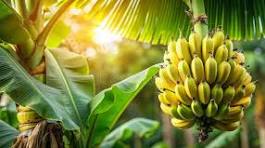
Identification and Cloning of MaTFX Transcription Factor and Its Potential Role in Regulating Anthocyanin Biosynthesis in Banana Publish Date : 20/07/2025
Identification and Cloning of MaTFX Transcription Factor and Its Potential Role in Regulating Anthocyanin Biosynthesis in Banana
Dr. R. S. Sengar and Abhishek Kumar Pathak
Introduction
Bananas are one of the most widely consumed fruits globally, known for their nutritional value and diverse range of flavors and colors. Anthocyanins, a class of flavonoid pigments, are responsible for the red, purple, and blue colors in many fruits, including bananas. These pigments not only contribute to the fruit's aesthetic appeal but also possess antioxidant properties beneficial to human health. Transcription factors (TFs) play a crucial role in regulating the biosynthesis of anthocyanins. In this article, we discuss the identification and cloning of the MaTFX transcription factor and its potential role in regulating anthocyanin biosynthesis in bananas.
The Role of Transcription Factors in Anthocyanin Biosynthesis
Transcription factors are proteins that bind to specific DNA sequences, thereby controlling the expression of genes involved in various biological processes, including anthocyanin biosynthesis. In plants, several TF families, such as MYB, bHLH, and WD40, have been identified as key regulators of the anthocyanin biosynthetic pathway. These TFs form complexes that activate or repress the expression of structural genes involved in anthocyanin production, thereby influencing the accumulation of these pigments in fruits.
Identification and Cloning of MaTFX Transcription Factor
Recent studies have focused on identifying TFs that regulate anthocyanin biosynthesis in bananas. Through bioinformatics and molecular biology techniques, researchers have identified a novel transcription factor, MaTFX, which belongs to the MYB TF family. The MaTFX gene was cloned from banana cultivars exhibiting high anthocyanin content. Sequence analysis revealed that MaTFX shares high homology with other MYB TFs known to regulate anthocyanin biosynthesis in other plant species.
Potential Role of MaTFX in Regulating Anthocyanin Biosynthesis
Preliminary functional characterization of MaTFX suggests that it plays a significant role in regulating anthocyanin biosynthesis in bananas. Overexpression of MaTFX in banana fruits resulted in increased anthocyanin accumulation, leading to enhanced red pigmentation. Conversely, silencing MaTFX expression led to a reduction in anthocyanin levels, confirming its role as a positive regulator of the anthocyanin biosynthetic pathway.
Mechanism of Action
MaTFX is believed to regulate anthocyanin biosynthesis by activating the expression of structural genes involved in the pathway. These genes include phenylalanine ammonia-lyase (PAL), chalcone synthase (CHS), dihydroflavonol 4-reductase (DFR), and anthocyanidin synthase (ANS), among others. By binding to the promoters of these genes, MaTFX enhances their transcription, leading to increased enzyme production and subsequent anthocyanin biosynthesis.
Implications for Banana Breeding
The identification and characterization of MaTFX provide valuable insights into the molecular mechanisms underlying anthocyanin biosynthesis in bananas. This knowledge can be applied to breeding programs aimed at developing banana cultivars with enhanced nutritional value and visual appeal. By manipulating the expression of MaTFX and other related TFs, breeders can potentially create bananas with increased anthocyanin content, thereby improving their antioxidant properties and marketability.
Conclusion
The MaTFX transcription factor has been identified and cloned from bananas, and its potential role in regulating anthocyanin biosynthesis has been explored. Further research is needed to fully elucidate the mechanisms by which MaTFX regulates anthocyanin production and to explore its potential applications in banana breeding. Understanding the genetic basis of anthocyanin biosynthesis in bananas will contribute to the development of new cultivars with enhanced nutritional and aesthetic qualities, benefiting both consumers and the agricultural industry.
Future Directions
Future studies should focus on:
1. Functional characterization: Further investigation into the specific mechanisms by which MaTFX regulates anthocyanin biosynthesis, including its interaction with other TFs and target genes.
2. Breeding applications: Exploring the potential of MaTFX in banana breeding programs to develop cultivars with enhanced anthocyanin content and improved nutritional value.
3. Biotechnological applications: Utilizing MaTFX in genetic engineering approaches to enhance anthocyanin biosynthesis in bananas and other fruits, thereby improving their quality and nutritional properties.

Writer: Professor R. S. Sengar, Director Training and Placement, Sardar Vallabhbhai Patel University of Agriculture and Technology, Modipuram, Meerut.


